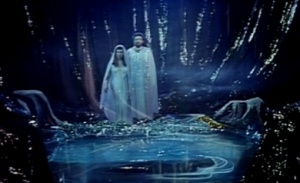
A meteor shower brings twin disasters: light that causes blindness in anyone who sees it, and carnivorous walking plants called triffids. Seaman Bill Masen (Howard Keel), hospitalized due to eye surgery, awakens to find civilization has fallen. Mason, along with Susan (Janina Faye), a sighted child he finds in a train crash, travel, searching for a way to rebuild society while avoiding triffids. Meanwhile, alcoholic scientist Tom Goodwin (Kieron Moore) and his wife Karen (Janette Scott), both still able to see, are trapped in a lighthouse surrounded by triffids.
And I really got hot when I saw Janette Scott
Fight a Triffid that spits poison and kills
If you don’t recognize that lyric, you’re likely to have missed two pivotal genre films, The Rocky Horror Picture Show and The Day of the Triffids. The latter affected the development of both science fiction and horror. Stuck in the middle of the first end-of-the-world cycle, it influenced post-apocalyptic tales until The Road Warrior. But its with horror that it’s really made its mark. The Day of the Triffids is the first modern zombie film. That may seem odd, since there are no zombies in it, but the triffids are pretty good stand-ins. They move slowly, making them easy to avoid, but if a victim is caught, he is devoured. They can be chopped apart, but that doesn’t kill them. OK, they are plants rather than dead humans, but that distinction is less important than you might think. And if you really need the sight of a man, groaning, walking in random directions and reaching out to grab prey, The Day of the Triffids supplies that too with its second zombie parallel, the blind. The mob, grabbing for the sighted girl, could have been taken from a scene in Dawn of the Dead.
The similarities to Romero’s Dead movies are striking: Something, never explained, happens in the sky and the next day the world is filled with altered people and civilization crumbles. A few, normal folks try to escape, and eventually end up caught in a building with the monsters (zombies/triffids) waiting all around them. But it it isn’t Night of the Living Dead that is closest, but 28 Days Later, where the word plagiarism comes into play. I’ve seen many named remakes that have less resemblance to their sources than 28 Days Later does to The Day of the Triffids. The beginning, with the hero surviving because he’s in the hospital, and then his walk through the quiet streets of London, is a direct steal.
I’ve been focusing on the importance of The Day of the Triffids and how it is often copied. Luckily it is also good. It does force the viewer to endure a brief prologue where a narrator explains what a carnivorous plant is, and a painful epilogue where he returns, after thankfully being absent for ninety minutes, to let us know that humans once again “have a reason to give thanks,” but those moments can’t pull down the rest of the movie. The first third is particularly powerful, dominated by the effects of a world gone blind. Obviously things don’t go well, particularly when flying planes and running trains are involved.
Musical star Howard Keel (Kiss Me Kate) seems like an unlikely sci-fi/horror hero, but his large size, good looks, and deep, distinctive voice makes him more memorable than the normal genre actors. He plays Bill Masen just the right amount larger than life. There’s a feeling that the entire production is just slightly removed from the English stage. Unfortunately, the triffids aren’t much more realistic than you might expect from such a stage play, but the camera rarely lingers on them.
Keel carries the film’s plot, but Kieron Moore and Janette Scott (School for Scoundrels or How to Win Without Actually Cheating!) carry the emotion. Their characters only interact with each other, and for them, the triffids are a relief, since they bring only external pain. Scott, who is one of cinema’s great screamers, is particularly effective as a devoted and defeated wife, who can do nothing but endure her erratic husband.
What I find most surprising is the cruelty in The Day of the Triffids. There is little attempt to aid the blind. Masen walks by lost, frightened people in the street, and does nothing. He voices a philosophical position that they should be abandoned, and only one character objects, and she later apologizes for it. I can’t tell if the filmmakers wanted us to sympathize with this, or be frightened of it. Either way, it’s interesting.
The ending is often attacked by purists for departing from the book’s more uncertain conclusion. While the novel’s open ending would work well in a film (and did, popping up in multiple zombie flicks), the movie’s ironic take on what can stop unstoppable opponents is more entertaining.








